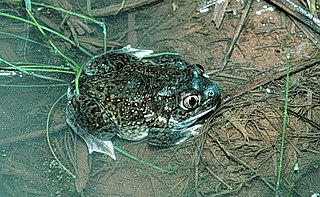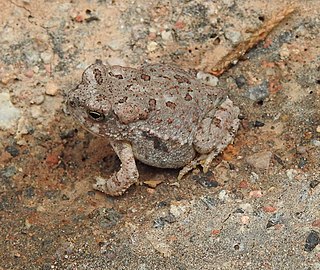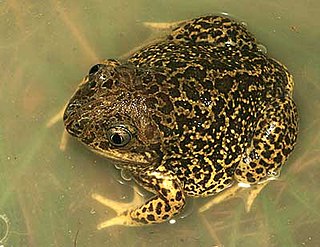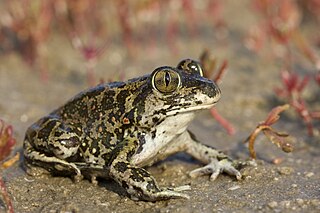
Amphibians are ectothermic, anamniotic, four-limbed vertebrate animals that constitute the class Amphibia. In its broad sense, It is paraphyletic group encompassing all tetrapods excluding the amniotes. All extant (living) amphibians belong to the monophyletic subclass Lissamphibia, with three living orders: Anura (frogs), Urodela (salamanders), and Gymnophiona (caecilians). Evolved to be mostly semiaquatic, amphibians have adapted to inhabit a wide variety of habitats, with most species living in freshwater, wetland or terrestrial ecosystems. Their life cycle typically starts out as aquatic larvae with gills known as tadpoles, but some species have developed behavioural adaptations to bypass this.

A frog is any member of a diverse and largely carnivorous group of short-bodied, tailless amphibians composing the order Anura. The oldest fossil "proto-frog" Triadobatrachus is known from the Early Triassic of Madagascar, but molecular clock dating suggests their split from other amphibians may extend further back to the Permian, 265 million years ago. Frogs are widely distributed, ranging from the tropics to subarctic regions, but the greatest concentration of species diversity is in tropical rainforest. Frogs account for around 88% of extant amphibian species. They are also one of the five most diverse vertebrate orders. Warty frog species tend to be called toads, but the distinction between frogs and toads is informal, not from taxonomy or evolutionary history.

A tadpole is the larval stage in the biological life cycle of an amphibian. Most tadpoles are fully aquatic, though some species of amphibians have tadpoles that are terrestrial. Tadpoles have some fish-like features that may not be found in adult amphibians such as a lateral line, gills and swimming tails. As they undergo metamorphosis, they start to develop functional lungs for breathing air, and the diet of tadpoles changes drastically.

The European spadefoot toads are a family of frogs, the Pelobatidae, with only one extant genus Pelobates, containing six species. They are native to Europe, the Mediterranean, northwestern Africa, and western Asia.

The Scaphiopodidae are a family of American spadefoot toads, which are native to North America. The family is small, comprising only seven different species.

A polyphenic trait is a trait for which multiple, discrete phenotypes can arise from a single genotype as a result of differing environmental conditions. It is therefore a special case of phenotypic plasticity.

Spea hammondii, also known as the western spadefoot, western spadefoot toad, Hammond's spadefoot, or Hammond's spadefoot toad, is a species of amphibian in the family Scaphiopodidae. It is found in western California (USA) and northwestern Baja California (Mexico). The specific name hammondii is in honor of physician and naturalist William Alexander Hammond.

Scaphiopus is a genus of North American amphibian commonly referred to as the North American spadefoots, southern spadefoots, or eastern spadefoot toads. They differ greatly from true toads by having eyes with vertical pupils, no parotoid gland, and relatively smooth skin. Their most distinctive feature is a spade-like projection on their hind feet, from which their common name is derived. This projection enables spadefoot toads to dig in loose soils with ease. Its scientific name means ‘spade-foot’ as well, from the Ancient Greek skaphís and pous.

Spea is a genus of North American amphibian commonly referred to as the western spadefoot toads. They differ greatly from true toads by having eyes with vertical pupils, no parotoid glands, and relatively smooth skin. Their most distinctive feature is a spade-like projection on their hind feet, from which their common name is derived. This projection enables spadefoot toads to dig in loose soils with ease. Its name is from the Ancient Greek speos

The Texas toad is a species of medium-sized toad that occurs in the southern United States and northern Mexico. It breeds in temporary water pools after heavy rains.

Couch's spadefoot toad or Couch's spadefoot is a species of North American spadefoot toad. The specific epithet couchii is in honor of American naturalist Darius Nash Couch, who collected the first specimen while on a personal expedition to northern Mexico to collect plant, mineral, and animal specimens for the Smithsonian Institution.

The plains spadefoot toad is a species of American spadefoot toad which ranges from southwestern Canada, throughout the Great Plains of the western United States, and into northern Mexico. Like other species of spadefoot toads, they get their name from a spade-like projection on their hind legs which allows them to dig into sandy soils. Their name, in part, comes from their keratinized metatarsals, which are wide instead of "sickle shaped". The species name translates as buzzing leaf shaped. This refers to the species' distinguishing features; its buzzing mating call, and its leaf-shaped digging metatarsals. It was first described by Cope in 1863.

The East Potrillo Mountains are a mountain range in south central Doña Ana County, New Mexico. They are located approximately 25 miles (40 km) west of El Paso, Texas, 30 miles (48 km) southwest of Las Cruces, New Mexico, and 30 miles east of Columbus, New Mexico. The southern tip of the range is less than 5 miles (8.0 km) from the Mexican border. The mountains and most of the surrounding acreage are located on land owned by the Bureau of Land Management. Access to the general vicinity is through New Mexico State Road 9, and several unpaved county roads.

Scaphiopus holbrookii, commonly known as the eastern spadefoot, is a species of American spadefoot toad endemic to the eastern United States. It is not considered a true toad.

The Arizona toad is a species of toad in the family Bufonidae. It is endemic to the south-western United States, where its natural habitats are temperate lowland forests, rivers and streams, swamps, freshwater marshes, freshwater springs, ponds, open excavations, irrigated land, and seasonally flooded agricultural land.

The Great Basin spadefoot is an amphibian in the family Scaphiopodidae. It is 3.8 to 6.3 centimetres long and is usually colored gray, olive or brown. Great Basin spadefoot toads have adapted to life in dry habitats. They use the hard, keratinized spade on each foot to dig a burrow, where they spend long periods during cold and dry weather. They are opportunistic hunters and will eat anything they can subdue. While their tadpoles have numerous predators, adults are able to produce skin secretions that deter enemies.

Pelobates cultripes is a toad species in the family Pelobatidae. It is known under many different common names, including the western spadefoot, Iberian spadefoot toad, Spanish spadefoot toad, and Wagler's spadefoot toad. It is found in most of the Iberian Peninsula with isolated populations southern and western France.

Pelobates syriacus, the eastern spadefoot or Syrian spadefoot, is a species of toad in the family Pelobatidae, native to an area extending from Eastern Europe to Western Asia.
















